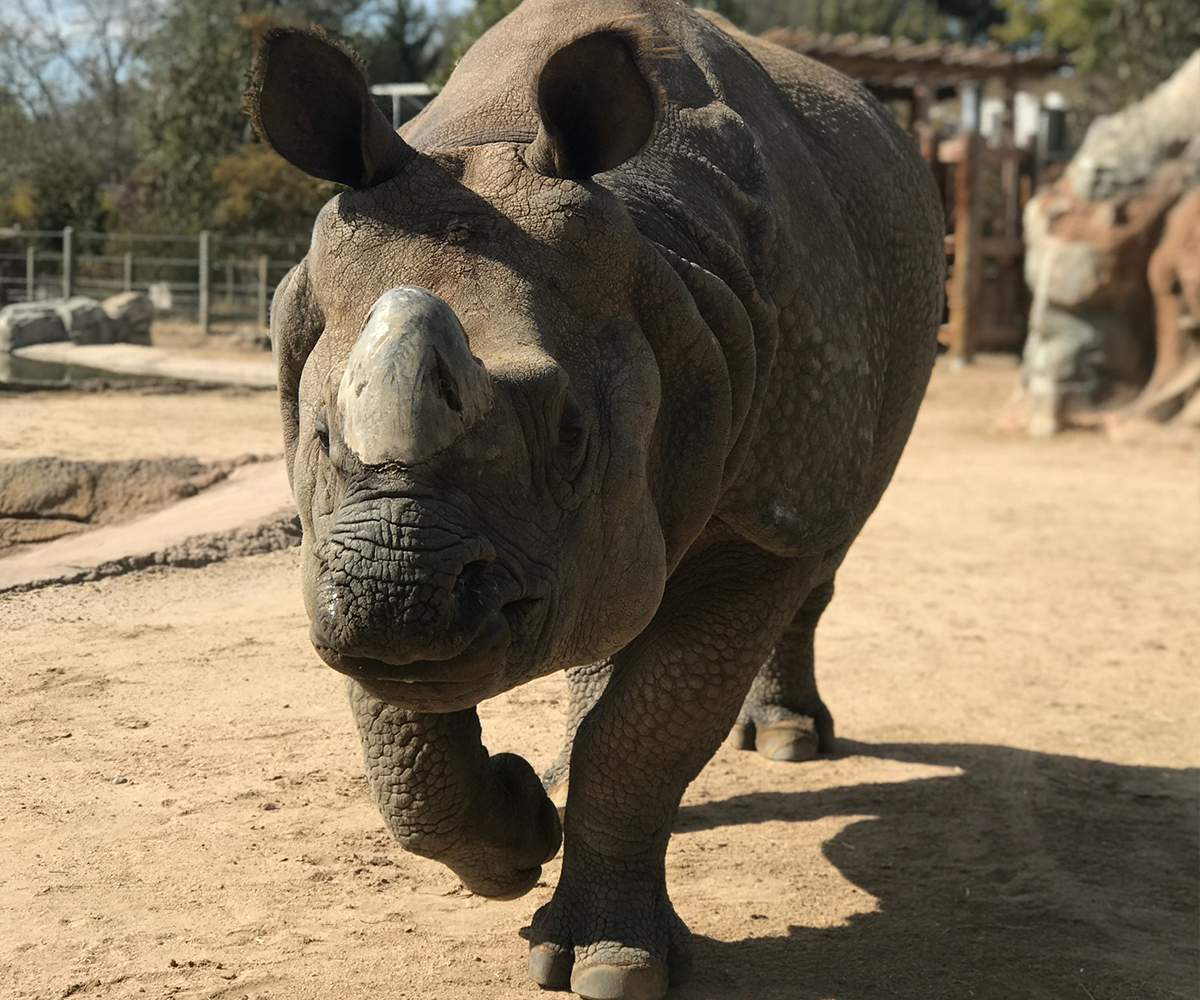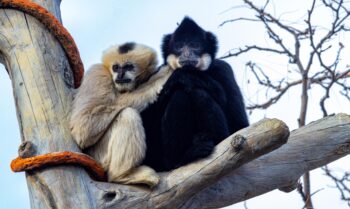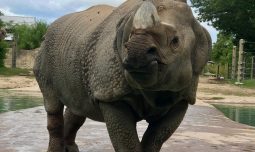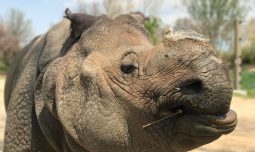September 15, 2020
Do You Know a Rhino?
Denver Zoo is Home to Four Rhinos with Distinct Looks and Personalities
By Mike Kainuma, Pachyderms Specialist
With nearly 3,000 animals here at the Zoo, most people have a tough time picking a favorite. I don’t have that problem. There are four animals that are extra special to me (and keep me pretty busy)—our resident rhinoceroses. Denver Zoo is home to two species of these magnificent animals—the black rhino and the greater one-horned rhino. And while all four may share some similarities, they’re different in some very interesting (and probably unexpected) ways.
Rudy

Rudy is our 26-year-old black rhino. Black rhinos are critically endangered and found in eastern Africa and are generally solitary. They often have long, shapely horns, and Rudy is no exception. A rhino’s horn has to its most distinctive feature. A “true horn,” like those on an antelope or a ram’s head, has a bony core at its center. A rhino’s horn sits on a bone pedestal, and is made of keratin like other horns, horse hooves, and our hair. In Africa, these pointy horns can come in handy when you have roaming prides of lions, or hungry hyena nearby and no herd to protect you.
Rudy is a particularly sweet natured animal. He loves a good scratch, whether that comes from his animal care team, or from guests participating in our Up-Close Animal Encounters program. Given the choice of eating or being scratched, Rudy will often choose a good back scratch or ear rub, which is pretty rare for an animal his size! On sunny days Rudy can be found snoozing on his favorite hill in the large pachyderm yard like the classic children’s book character, “Ferdinand the Bull.” Rudy is typically in his big outdoor yard from 9:00 to 3:30 p.m. in the summers enjoying the sunshine. If you don’t see him out there, he’ll be inside, enjoying his cushioned floor stalls.
Tensing

Not too far from Rudy is Toyota Elephant Passage, home to Tensing ,Joona, and Bandhu, our greater one-horned rhinos. Greater one-horned rhinos are found in India and Nepal and are listed as “vulnerable” by the International Union for Conservation of Nature. Because they’re also solitary, Tensing and Bandhu can be seen in different yards and might be hard to tell apart. Tensing, our 12-year-old female, is smaller, with a more delicate frame (the only time I’ll use “delicate” to describe a rhino). Tensing is known as a sweet and gentle girl. To tell her apart from Bandhu, look at her horn and look for her calf, Joona! Tensing's horn is smaller and dome shaped. How does it get that way? Well, we’ve never trimmed a rhino horn here at Denver Zoo—she does this herself, by rubbing it on hard surfaces in her habitat.
Joona

Tensing and her daughter Joona live together. And while Tensing's daughter looks and acts just like her mom, for now, the easiest way to tell Joona apart is that she's the smallest rhino around.
Bandhu

Bandhu, our male, is the largest of all our rhinos at 4,800 pounds (about as much as a Toyota 4Runner). At 10 years old, he’s a teenager in rhino world, so he can be a little moody. Sometimes that mood is goofy, especially when giant plastic toy balls are involved. He also enjoys patrolling his yards, a job he takes very seriously. Thanks to the design of Toyota Elephant Passage, Bandhu has five different yards to patrol, and you never know which yard you’ll see him in when you come visit. You’ll know you’re looking at Bandhu because his horn is conical and somewhere between Rudy’s and Tensing’s in shape and size.
Greater one-horned rhinos generally have smaller horns because they have two giant incisors for protection. Being from India and Nepal, adults don’t have any predators, so those teeth are for showing other rhinos who’s boss. You may also notice thick folds of skin on the greater one-horned rhinos. This armor protects their vital areas, the chest and neck, like the skin of a shar pei, only scaled up to rhino size. Bandhu’s been growing his horn out lately, and I make a point to compliment it whenever I see him.
Unique Ungulates
Our planet is home to only five species of rhinoceros, and I’m so glad we have two of them here. We often hear about a particular type of animal, like a whale or bear, and we have a mental image, or notion about who they are, where they live, what they eat, and what their social structure is. It’s when we dig a little deeper that we truly appreciate the uniqueness of a species right down to the individuals. That’s what I find so fascinating about our four rhinos, and they still surprise me every day.
Subscribe
Be among the first to hear the latest animal updates, important stories and details about all the fun happening around Denver Zoo.
Tags
-
 April 15, 2024
April 15, 2024Good Luck, Chuck!
Good Luck, Chuck! Beloved Bachelor Relocating as Part of Asian Elephant Species Survival Plan In a heartfelt and collaborative…
-
 April 15, 2024
April 15, 2024African Impact
African Impact Two New African Field Conservation ProgramsAim to Protect Gorillas + Grey Crowned Cranes We're honored to provide…
-
 March 1, 2024
March 1, 2024Last Place(s) on Earth
Last Place(s) on Earth New Asian Field Conservation Programs Protect Asian Elephants, Sumatran Orangutans + more Indonesia's Leuser Ecosystem…




